THURSDAY
NOVEMBER 15 - 2012
BROOK
MEADOW
I attended this
morning's conservation session on the meadow, mainly
to take photos of the workers. The main job was to
make use of a pile of tree chippings, that had been
left on the edge of Palmer's Road Car Park by Council
workers, to lay down on muddy paths on the north
meadow and in Palmer's Road Copse.
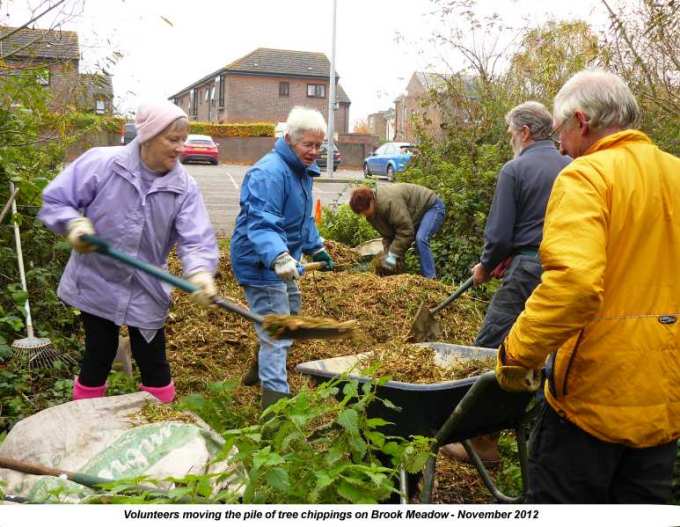
Mystery
waterweed
I managed to get a
sample of the dark green filamentous waterweed from
the river. The plants are attached to stones on the
bed of the river and their long stems have branches
with numerous very thin grass-like filaments.
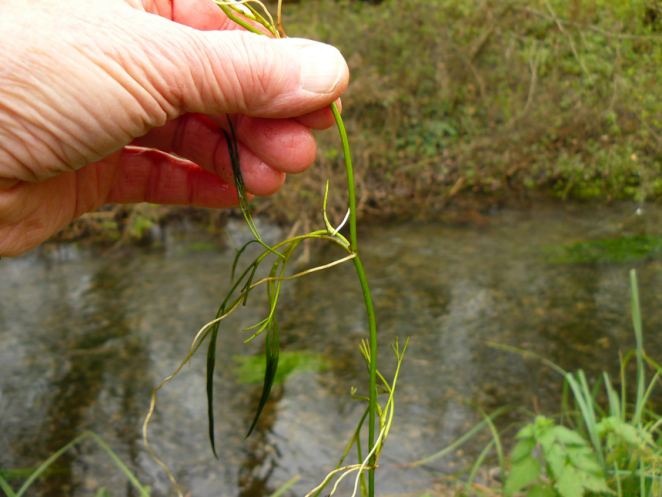
Here
is a shot of it in the river

It reminded me of Eel
Grass, though I realise that is a marine plant.
However, I gather from a web search that there are
freshwater Eel Grasses, used in aquaria, which can
become a pest when they escape into natural waterways.
Can anyone help?
Here
is another photo of the weed taken at home with a
plant still attached to a stone.

Hemlock
Water-dropwort
Following my discovery
of Hemlock Water-dropwort flowering in the Lumley pool
yesterday, I found several more plants in full flower
further north up the Lumley Stream. The plants looked
quite fresh, so I guess this is a second flowering
rather than left overs from earlier flowerings.
NORE
BARN
15:45 - 16:15 - Tide
falling from high water at 11:45. Weather overcast and
very dull with a November chill in the air.
Spotted
Redshanks
Stream was still quite
full of water, but the Spotted Redshank was already
present along with the regular Lapwing. A second
(unringed) Spotted Redshank arrived in the stream at
15:00 and was immediately confronted by the 'resident'
bird and they both flew off. I saw the resident
Spotted Redshank later on the shore around the point,
but there was no sign of the second bird.

For
all the current news and photos go to
. . .
Spotted
Redshank 2012-13
Swan
Attack
I met Roy Ewing of the
Nore Barn Woods Conservation group who gave me some
more information about the dog attack on Mute Swans at
Nore Barn on Nov 7. The attack was witnessed by HBC
workers who were present for the seawall construction
and one of them helped to fend off the dog, but not
before it had killed one swan and injured another. Roy
has put a photo on their notice board of a the Council
worker and a member of the RSPCA removing the injured
swan for treatment.
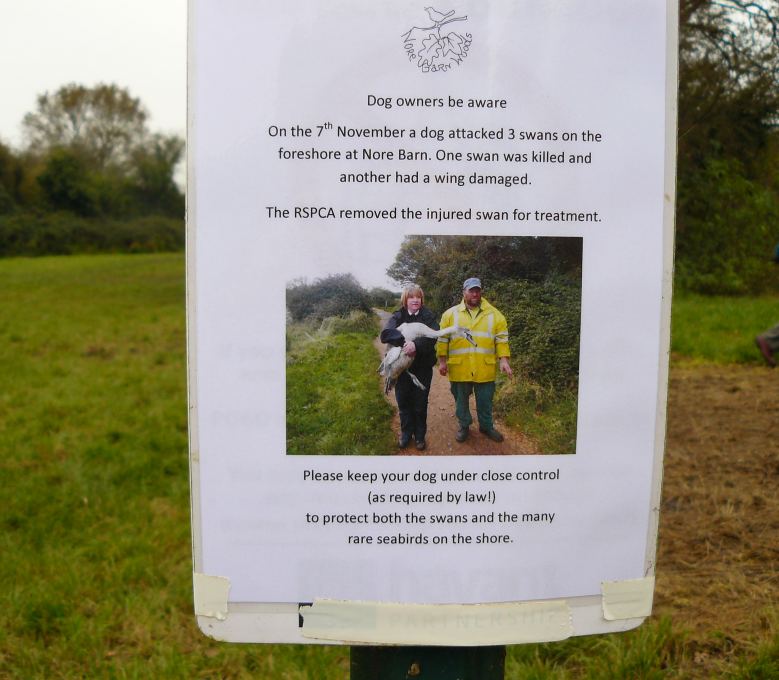
INSECT
CORRECTION
Martin Jenner e-mailed
to say the insects feeding on Ivy flowers on the web
site (Nov 8 and Nov 6) which I labelled as bumblebees
were in fact hoverflies. He said they look like
Eristalis tenax (a bee mimic), though it
is difficult to tell from the angle. Martin says, if
you look closely you will see it has only one pair of
wings, whereas Hymenoptera which include bees have two
pairs. Its flight period is March to November, so
seeing it now is not unexpected.

The fact that the
Eristalis hoverfly is a bee mimic makes me feel not so
bad over the misidentification, though I really should
have recognised it as I also had one pointed out to me
on Nov 3 by Ralph Hollins and Tony Davis. I trust I
shall not make the same mistake again (though don't
hold your breath!).
WEDNESDAY
NOVEMBER 14 - 2012
NORE
BARN
14:00 - 15:00 - About
3 hours after high water. The tide was still well in
when I arrived, though the stream was emptying. The
weather was fine with bright sunshine, but too bright
for decent photography. John Hilton from Winchester
was already in place with his camera on the
saltmarshes. Ron from Emsworth was on the beach with
his brand new scope.
The
stream
The first birds in the
stream were a Lapwing and a Black-tailed
Godwit, both regulars. The Spotted Redshank
followed fairly soon after, but there was no
Greenshank and no second Spotted Redshank. The
Spotshank and the Godwit fed together much as the
Spotted Redshank and the Greenshank usually do and I
got a nice photo of them together.
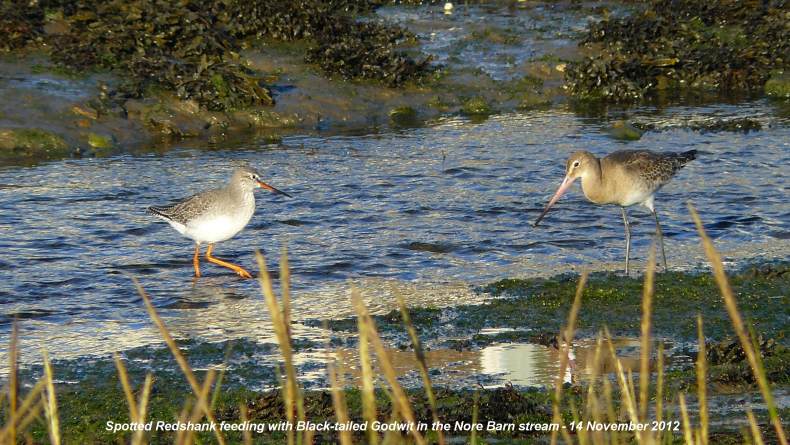
About 200 Brent Geese
were feeding on the western mudflats along with Wigeon
and Teal. I also saw about 50 Black-tailed Godwits,
but they were too far away to go through for
colour-rings.
Seawall
reconstruction
I met Roy Ewing who
told me the good news that phase one of the
construction work on the shoreline has been completed
on time and within budget. However, the second phase
involving the placement of concrete blocks will be
more expensive and will take time to complete. In the
mean time, the group hope the new earthworks will
survive the winter storms.
Mute
Swans attacked
Roy also told me some
nasty news that two Mute Swans had been savaged by
dogs at Nore Barn. One swan was killed and the other
badly injured. The RSPCA removed both animals. This is
not entirely surprising as swans cannot move quickly
to avoid an attack like the small ducks and waders,
but it is disturbing that some owners have so little
control over their animals.
TUESDAY
NOVEMBER 13 - 2012
BROOK
MEADOW
Waterweed
The dark green
waterweed is far more extensive in the River Ems than
I first realised. It is very dense in front of the
gasholder as well as below the S-bend. I previously
referred to it (Nov 11) as Canadian Waterweed
(Elodea canadensis), though the long thin,
almost grass-like, leaves of the plant are quite
different from that described in the guides. I need to
get some out to look at it more closely. Does anyone
know what it is?

Black
Poplars
The two Black Poplars
can now be seen very clearly from the main seat
overlooking the meadow. They have grown to their
present height from small saplings when they were
planted in November 2004. The one on the left was
blown over in 2008 and had to be lopped and hauled
back upright, but it does not seem to have suffered as
it is not far behind the height of the original
unlopped tree.
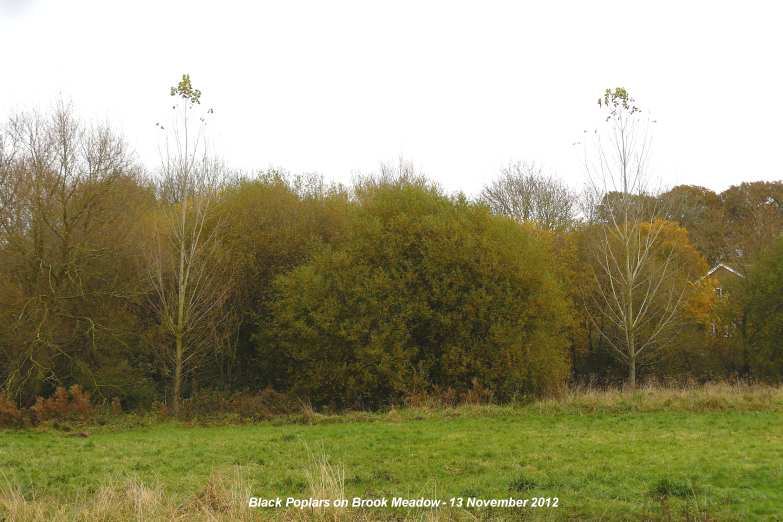
Hemlock
Water-dropwort
I was surprised to see
several plants of what I assume is Hemlock
Water-dropwort in full flower in the open area of the
Lumley Stream (called the Lumley Pool) just north of
the Lumley Path footbridge. According to the books its
flowering period is May-Aug.
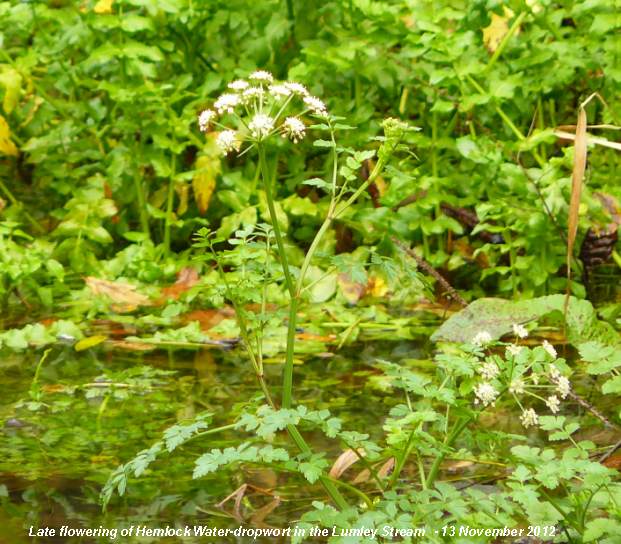
MILLPOND
NEWS
Great
Black-backed Gull
What looks very much
like a juvenile Great Black-backed Gull was on Peter
Pond. I wonder if it was one of the two from the nest
on Slipper Millpond?
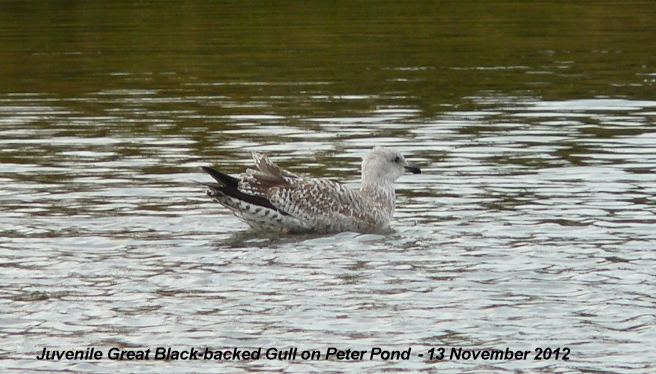
Common
Gulls
One adult Herring Gull
and about 6 Common Gulls were on Slipper Millpond
along with the usual 100 or Black-headed Gulls.
Here
are two of the Common Gulls on the south raft with a
few Black-headed Gulls

Tufted
Duck
The first Tufted Duck
(male) of the year was on the town millpond this
morning. They are a bit later than usual arriving on
the millpond. Last year we had the first pair on Oct
28.
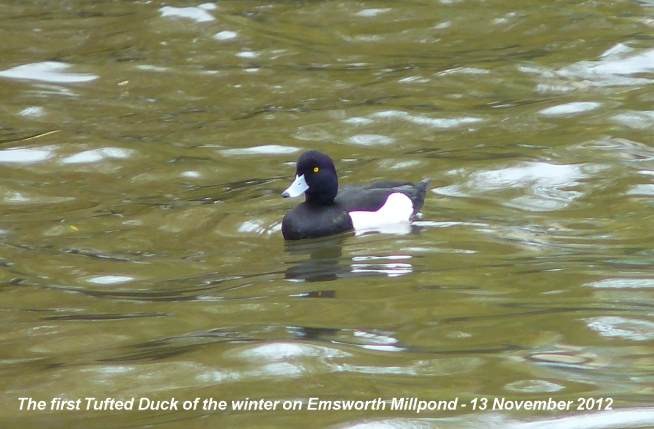
Mallard
family
Stephanie Bennett of
Bath Road, Emsworth provided interesting observations
about the development of the Mallard ducklings which
were born in August on Emsworth Millpond. There were
originally 10, but 9 survived. They are all grown up
now, but they still spent a lot of time together. They
have learnt to fly recently, but they don't venture
far so can easily spotted as a distinct group.
I too have been
watching this Mallard family and mum has certainly
done a sterling job keeping them out of harm's way.
Mallard ducklings are so vulnerable and often get
taken or die in the early stages of life.
NUTBOURNE
BAY
14:00 15:00 - From the
end of Farm Lane I walked along a very muddy path to
the coast. I came back by an easier route along the
dry track through the old Chichester Harbour
Conservancy conservation area. It is worth knowing
about this alternative route when conditions are
muddy. There is a well used route through the hedge at
the start of the path and another casual path up to
the seawall at the end.
I caught the tide just
right for the birds with about 4 hours after high
water. The tide was falling fast and the mudflats
emerging. I was greeted by masses of birds in the bay
with hundreds of Brent Geese, Wigeon and Teal. I saw
just one pair of Pintail in the channel. There
were some spectacular flights of Dunlin.
Des Barker and Pam,
his sister in law, were on the seawall when I arrived,
looking for Avocets, but they had not seen any.
However, as we were talking, 14 Avocets flew
into the bay. They did not stay long and flew further
out to feed on the edge of the main channel. Much too
far for a photo. I think the maximum so far this
winter for Nutbourne is 19 or 20.
The fresh water stream
that enters the bay is very similar to the one at Nore
Barn and attracts similar range of birds. Today, the
colour-ringed Spotted Redshank W+GY was feeding
in the stream with the regular colour-ringed
Greenshank GY+GY and another un-ringed
Greenshank and a Common Redshank for about 30 minutes
until the tide fell.
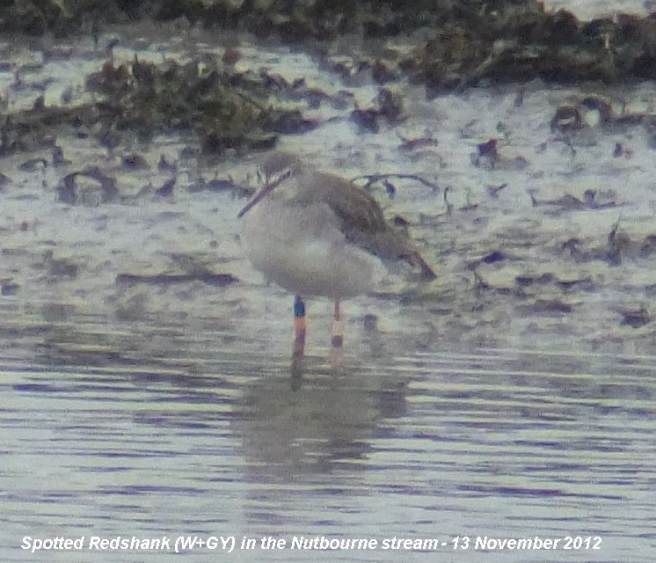
I counted 74
Black-tailed Godwits which included just one
colour-ringed bird: W+LW. I thought at first it
was the familar WO+LW flag which I have seen several
times in Emsworth this winter period. but I could not
see the orange ring or the flag. My only previous
record of W+LW was by Richard Somerscocks in Emsworth
Harbour on 06-Nov-11.
I spotted two
Bar-tailed Godwits feeding with the Black-tails
which stayed feeding when the Black-tails flew off.
These were the first Bar-tailed Godwits I recall
having seen at Nutbourne.
I aged 280 Brent
Geese and found just 3 juveniles in two families
of two and one. My proportion of juveniles to adults
for the winter so far stands at 1.66 - not a good
breeding season for the Brents.
MONDAY
NOVEMBER 12 - 2012
GARDEN
A Red Admiral was
fluttering around in the drizzle this morning. I got
the following snap as it came to rest on a tree with
its wings closed.
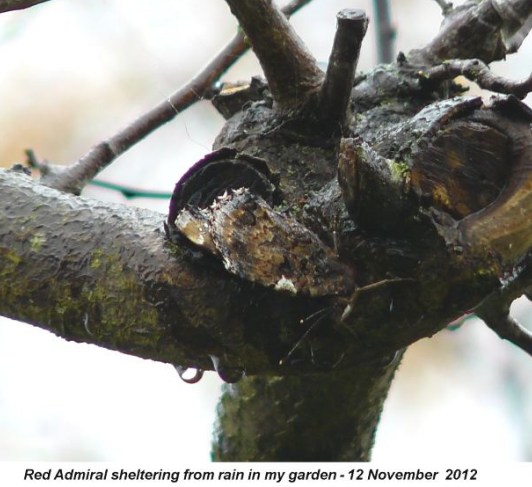
RALPH'S
NEWS
Here are a few
snippets from the wildlife summary for the past week
from Ralph Hollins. See for the complete version . . .
http://ralph-hollins.net/Summary.htm
Little
Egret: Ralph
thinks the Langstone Pond trees may have been
abandoned as a night roost. They probably now head for
Thorney Little Deeps east which had a roost of 75
birds on Oct 28.
Mute
Swan: Ralph
saw two flying past Langstone Pond on Nov 5 though he
suspects some have been flying for a month or more . I
have certainly seen Mute Swans flying from Emsworth
Millpond into the harbour in the past week.
Red-Breasted
Goose: The
bird that has been at Farlington Marshes since Oct 25
was still there on Nov 10 and it remains the only one
currently in southern England.
Goldeneye:
So far November had brought two to the Pagham Lagoon
on Nov 3 and five to Langstone Harbour on Nov 7 but we
are still waiting for the influx that normally occurs
before the end of October.
Avocet:
By Nov 2 more than 190 were already in the Exe estuary
in Devon and on Nov 3 a party of 20 were seen in
Nutbourne Bay (east of Thorney Island) where some have
spent the winter in past years.
Waxwing:
It could be another good year. BTO Bird Migration Blog
reported 2000 in the UK and latest local news is of 8
near Basingstoke on Nov 11
Sweet
Violet: Two
weeks ago Ralph announced the find in Havant St
Faith's churchyard of the first Sweet Violet flower of
the new season. This week he discovered that the
flowers are attractive to Pigeons and Sparrows for the
sugars in them and when few are emerging they tend to
get eaten up as soon as they open. Has anyone seen
this happening?
FINDHORN
NEWS
At my request, Richard
Somerscocks sent me this fine image of two Twite.
Richard tells me they were seen on 1 Nov at Burghead,
a small fishing village about 7 miles east of
Findhorn. The local bird recorder says they are
relatively uncommon in Moray and apparently most of
the sightings are in the Findhorn area. Although he
suspects there may be more among the flocks of
Linnets, but they simply don't get looked at.
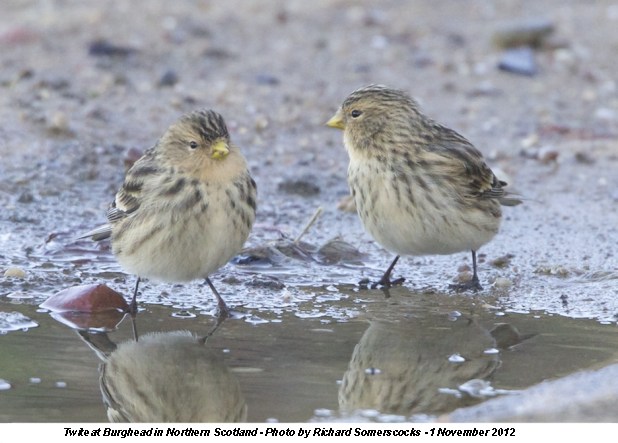
The Birds in Moray and
Nairn web site has a number of Richard's photos. See .
. . http://www.birdsinmorayandnairn.org/bird-recording/recent-records/
There are also many sightings of Waxwings on the web
site, though Richard has yet to see one. If he does he
promises to send us a photo to savour! Maybe, we shall
get some down here this year?
The last Twite I saw
locally were two on the shore at Langstone near the
entrance to the Langbrook Stream on 14 January 2003. I
think there were three sighted, but I only saw two.
Here is my photo from the time.

SUNDAY
NOVEMBER 11 - 2012
BROOK
MEADOW
Fly
fishing
I had an early morning
stroll through the meadow where I met a very
knowledgeable young lad fly fishing in the river near
the north bridge. He said he had seen some good sized
Brown Trout and had a few bites, but no catches. He
showed me his fly which he had made himself. Maurice
Lillie who had done some fly fishing as a youngster
came along with his three little dogs. Maurice and the
young lad had a fishing chat during which I learned
the difference between wet and dry fly fishing.
Although the conservation group do not encourage
fishing in the river, I certainly see no harm in a
single enthusiastic lad indulging in his hobby. Good
to see.
Canadian
Waterweed
As we were walking
along the main river path south of the S-bend, Maurice
and I noted a several lush growths of waterweed in the
river. There appeared to be two species, one with long
thin dark green leaves stretching out in the current
and the other with shorter light green leaves. Maurice
thought the former was Canadian Waterweed which he had
also seen growing on the River Itchen.
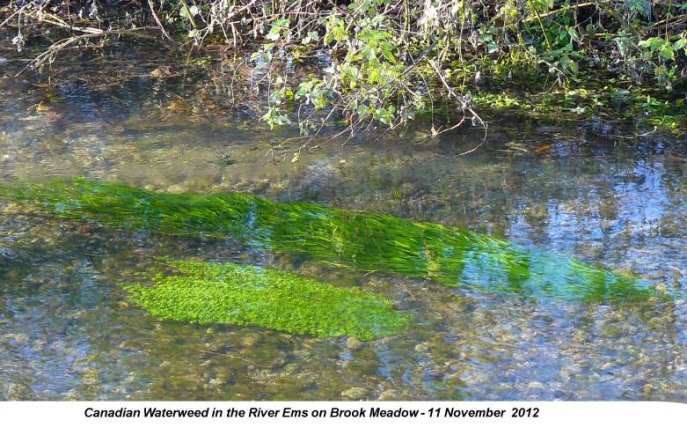
Canadian Waterweed
(Elodea canadensis) is native to North and
South America and was first recorded in Britain in
1842, subsequently spreading rapidly. It can form
dense stands in ponds and water courses and relies
entirely on vegetative reproduction for its spread.
Although it is now regarded as a naturalised aquatic
plant, it causes problems by competing for nutrients
and outgrowing many native species. There are some
large areas of this weed in the River Ems,
particularly near the Bulrushes.
The Hants Flora says
it has now been supplanted in some places by the very
similar Nuttall's Waterweed (Elodea nuttallii)
which is another introduced species. The description
of this plant would seem to fit the dark green plants
in the river better than Canadian Waterweed. I shall
need to fish some out to have a close look at them.
Andy Powling
discovered some Canadian Waterweed beneath the south
bridge during his survey of the River Ems on Brook
Meadow on 13 June 2005.
NORE
BARN
11:15 - 12:15 - Tide
falling from high water at 08:38. The stream was still
full of tidal water when I arrived, but the 'resident'
Spotted Redshank was already present. It was
joined later by the regular Lapwing, the Greenshank
and 4 Black-tailed Godwits. But there was no sign of
the second Spotted Redshank. The sunshine created some
great reflections in the water.

For
all the Spotted Redshank news go to the special web
page at . . . Spotted
Redshank
I was pleased to meet
up with David Holloway at Nore Barn. David had
previously e-mailed me about the best time to see the
Spotted Redshank in the stream. He will soon be moving
to Emsworth to live in one of the deck houses near
Emsworth Marina and we look forward to his
contributions to local bird sightings.
I counted 180 Brent
Geese on the western mudflats, but no juveniles. The
Black-tailed Godwits were relatively few in number
today (c50) and scattered around the mudflats, so
there was no real opportunity to look for
colour-rings.
Several Golden
Samphire flowers were still open on the seawall
south of the woods.
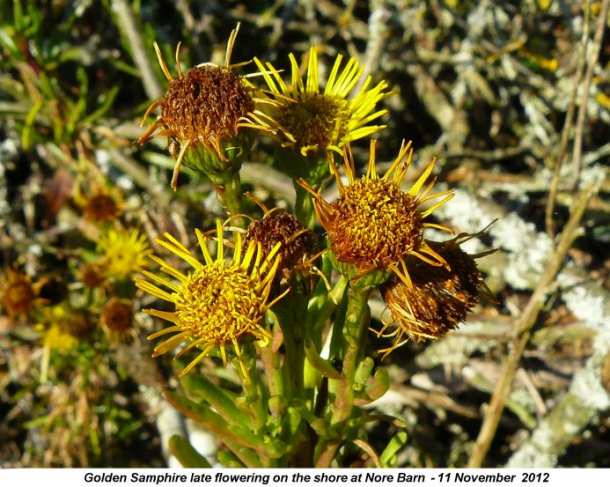
FINDHORN
NEWS
As a supplement to
yesterday's news, Richard Somerscocks says they never
get Spotted Redshank up in Scotland, but make up for
this with masses of Common Redshank.
Here
is Richard's shot of a roosting flock of Common
Redshank in Findhorn bay.
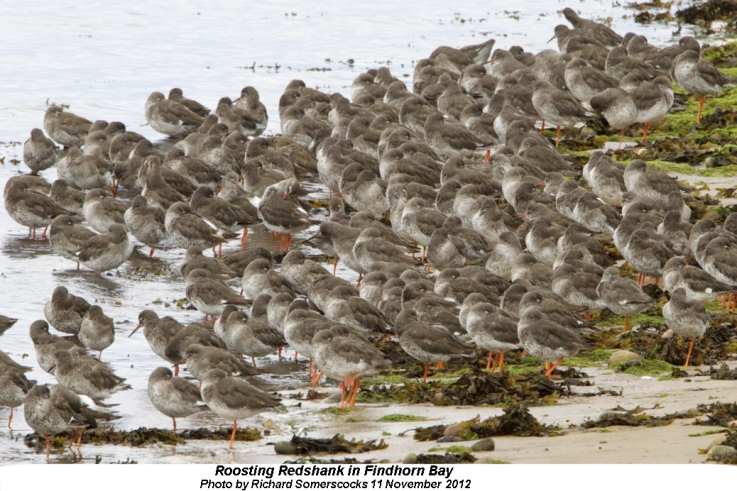
SATURDAY
NOVEMBER 10 - 2012
GARDEN
NEWS
Winter
Blackcap
We had our first
'winter' Blackcap in the garden today. A female with
her distinctive brown cap was first seen feeding in
the Buddleja bush. Then she dropped down to have a
bathe in the plastic tray which passes for a bird
bath.
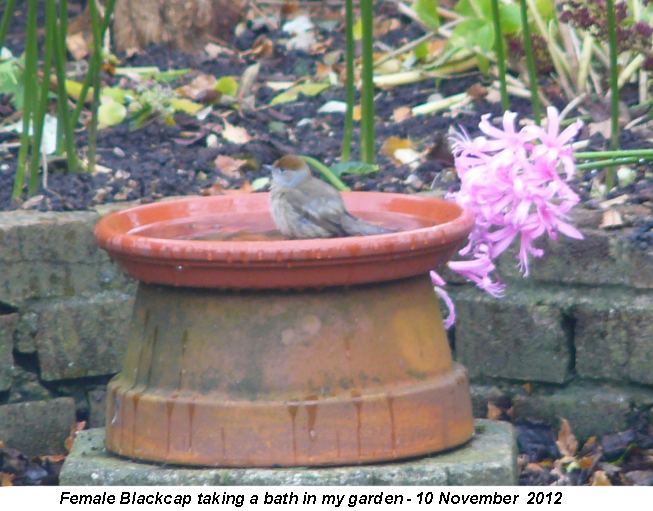
Blackcaps which winter
in this country are generally considered to be a
different population from the summer migrants from the
Mediterranean. Ringing studies have established that
Blackcaps regularly migrate from The Continent to
spend the winter in this country, often visiting
gardens.
Wintering Blackcaps
are not uncommon in my garden; I have recorded them in
most of the 15 years I have been in my present house
in Bridge Road, both males and females. In fact, this
year, for the first time I had a pair visiting the
garden in June which must have been summer migrants.
Today's sighting takes to 14 the number of species
recorded in my garden this week, which is a very good
tally.
BROOK
MEADOW
Water
Vole
Maurice Lillie saw a
Water Vole at 08.55 north of north bridge yesterday
(Nov 9). About 45 metres north of the north bridge a
water vole emerged from long grass. It ran seemingly
very determined, southwards about 50cms above water
level for about 25metres in a random route, exposed to
view as there is little cover there now. En route it
stopped once for about half a minute, out of sight,
then resumed its journey to a concealed behind
overhanging ivy. Throughout it seemed to be unaware or
certainly unconcerned by my presence or that of my
three dogs.
Pheasant
Maurice Lillie asks if
anyone else seen the female pheasant that seems to be
lurking in the north meadow? He has seen it four
times. The answer is Yes. Debbie Robinson reported
this Pheasant to me on Nov 6.
Ash
saplings
Maurice counted 55 Ash
saplings along the north path beside the river. He
also noticed the huge quantity of seeds on the large
Ash tree in the north west corner, which must account
for so many saplings in that area. Maurice wonders if
we should gather these and keep them for the time when
die back destroys the stock of trees.
OTHER
NEWS
Roadside
Fungi
Keith Wileman sent me
the following photo of a big clump of fungi growing on
the grass verge between New Brighton Road and Lewis
Road opposite the end of Conigar Road. He thinks they
might be Honey Fungus again, like those in Danbury
Court. Quite possible I would think.
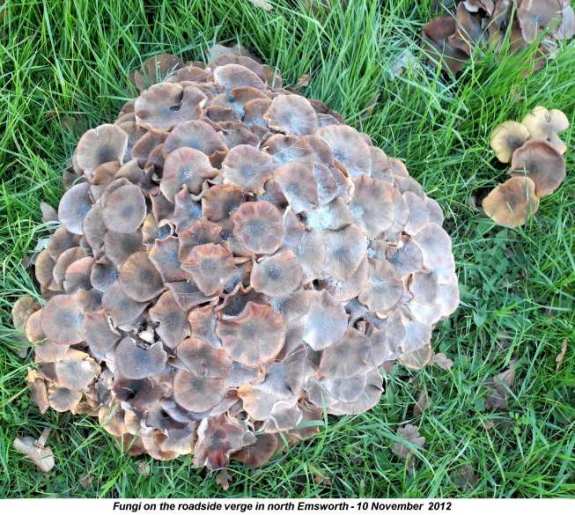
Avocets
Janet Hider walked
today from Nutbourne to Prinsted, about three hours
after high tide. She counted 15 Avocets on the shore
in Nutbourne Bay and got the following photo. Janet
also noted lots of Brent Geese, Wigeon and Dunlin.
Curlew, Oystercatchers, Little Egrets and Turnstone
plus a few Godwits were at Prinsted. Janet's verdict:
A brilliant day for birdwatching!
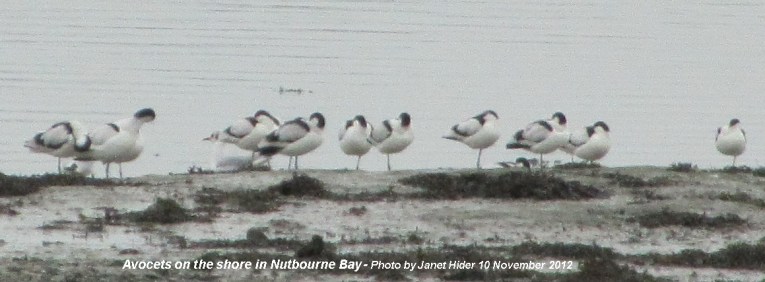
Water
Rail migrants
BTO reports that ring
recoveries show that the British and Irish Water Rail
population is augmented in the winter by birds from
Fennoscandia and central Europe, coming to take
advantage of the generally milder weather over here.
Although freezing weather conditions in some winters
generally offer the best opportunities to see Water
Rails, the arrival of these autumn migrants, and the
subsequent increase in 'sharming' (squealing calls),
contributes to a sharp rise in the Water Rail
reporting rate at this time of the year see . . .
http://ctt-news.org/NXN-11KP5-3GJW16-EMRZH-0/c.aspx
NEWS
FROM FINDHORN
Richard Somerscocks
provided the following news up date from his new home
in Findhorn in Northern Scotland
"Black-tailed
Godwits are still present in Findhorn Bay. I
counted 6 today and that included WN+OY flag which has
now been with us for about 2 weeks.
It has been fairly
windy here for the last few days which has made
birdwatching more challenging. Quite a lot of ducks
are in the bay though at the moment, including both
Red-breasted Mergansers and Goosanders. These
birds, particularly the females, can look fairly
similar at a distance but when seen close up the
differences become apparent. The Mergansers tend to
favour the more open sea, whereas the Goosanders stay
almost exclusively in the bay. This behaviour was also
apparent in the sightings I got when I was at
Emsworth. The Mergansers were often seen off Thorney
Island and the few sightings I had of Goosanders
tended to be on Great Deep.
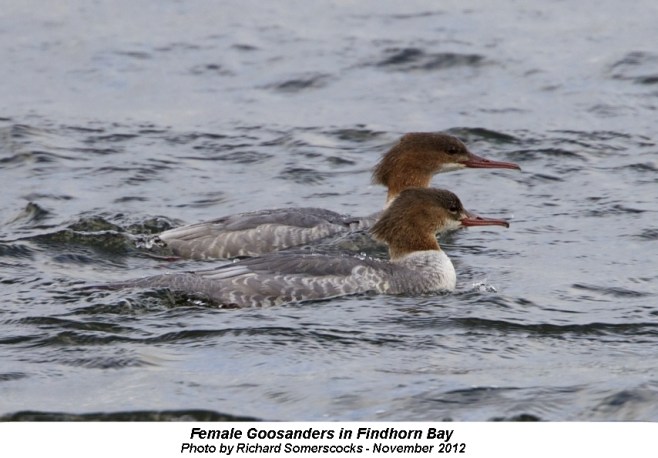
I notice that you are
getting Pintails at Emsworth and we also have
around 50 in Findhorn Bay at the moment.
Another bird I saw
yesterday were a number of Sanderlings. They
tend to favour long sandy beaches where they can rush
around endlessly feeding by the water's edge. It does
make photographing them difficult! I cannot recall
seeing them at Emsworth but I expect somewhere like
the Witterings may have some. The ones I saw were on
the beach at Lossiemouth which is just along the
coast.
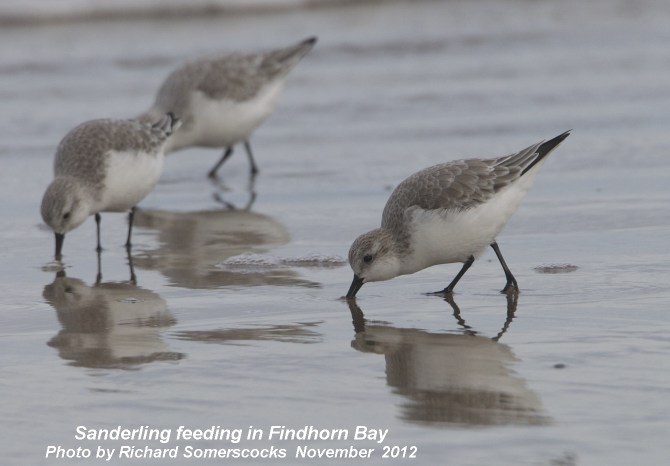
Finally, on the shore
I have also seen a few Snow Bunting here at
Findhorn.
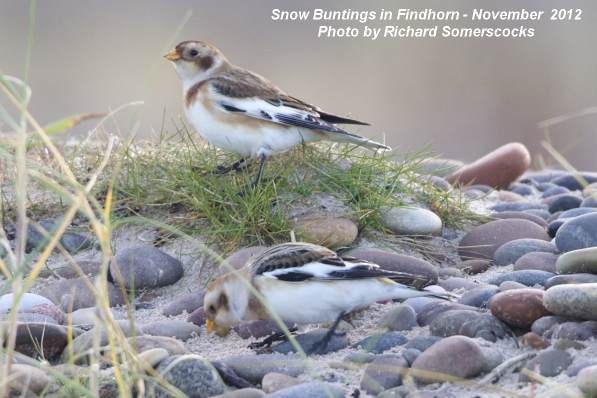
FRIDAY
NOVEMBER 9 - 2012
NORE
BARN
09:45 - 10:45 - Tide
falling from high water at 06:42, so about 3 hours
after. The weather was cloudy and dull with a brisk
and very chilly westerly wind. I was pleased to meet
up with Richard Hallett who was making his first visit
to Emsworth of this winter season.
The
stream
Richard and I were in
luck as we both had excellent views of the two
Spotted Redshanks in the lower stream. We were
able to see the difference in leg colours between the
two birds, with the 'resident' bird having paler red
legs than the 'visitor'. There was a little bit of
chasing by the resident bird, but not serious enough
to drive the visitor away. There was a nice collection
of other species in the lower stream, including 6
Black-tailed Godwits, 1 Lapwing, 2 Teal and 6 Wigeon.
The Greenshank was there when I first arrived but it
moved away.
Malcolm Phillips was
at Nore Barn a little later and got this nice image of
the Lapwing in the stream.
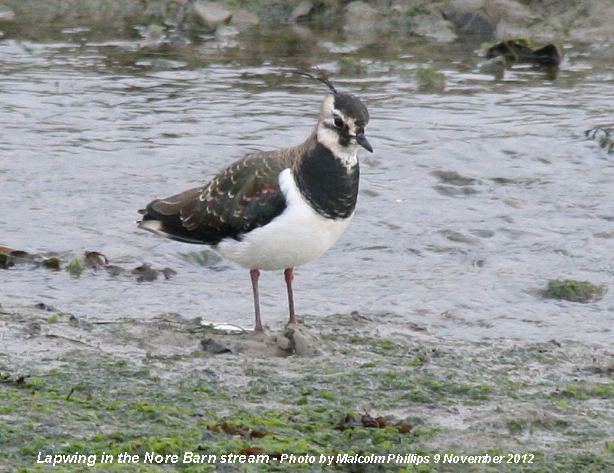
The
mudflats
I counted 47
Black-tailed Godwits feeding on the mudflats at
Nore Barn, including two colour-ringed birds, both
regulars this season: ROL+RLR and WO+LW flag. I also
spotted two Knot feeding among the godwits, the first
in Emsworth this autumn. I counted 146 Brent Geese
on the western mudflats including 3
juveniles. The juveniles were well spread out
suggesting they were in three separate families.
Richard's
news
After I left Richard
had a distant but clear view of a Knot on the mudflats
and a very close view of a very tame Greenshank in the
small stream at the top of Nore Barn Creek. It could
be the one that usually feeds with the Spotted
Redshank in Nore Barn Stream, though there are at
least two Greenshank in this area. Richard was also
pleased to get close views of a Grey Plover and a tame
Curlew all of which made him wonder what is it about
the Emsworth birds that makes them so approachable! I
suppose it must be that Emsworth is such a friendly
place!
OTHER
NEWS
Sparrowhawk
in garden
Patrick Murphy had two
visits from male Sparrowhawk this morning. Patrick
says, "The first caught me unawares when it landed on
a feeder stand about 5 ft the other side of the
window. Unfortunately, my camera was in its case and
by the time I had it ready the bird flew off. It
returned about 10 minutes later and this time camera
was at the ready. As you can see the bird landed in
our apple tree and stayed only briefly as all the
feeding birds had disappeared. The hawk was unlucky on
both occasions."
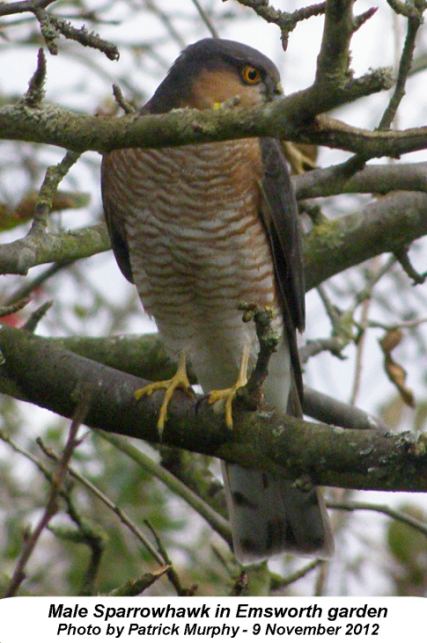
Patrick's excellent
photo shows the barred rufous underparts of the male
Sparrowhawk very well. As well as being much larger
than the male, the female Sparrowhawk has darker and
finely barred underparts and also has a pale
supercilium which the male bird does not have.
Garden
caterpillar - Buff Ermine
Regarding the photo of
the caterpillar that I took in my garden yesterday,
Ralph Hollins reminded me that I had a similar
caterpillar back in September which seemed likely to
be a Buff Ermine moth and he believes the current one
is the same species. Ralph referred me to a photo of a
caterpillar on the ukleps website in which the white
stripe down the back matches my photo.
http://www.ukleps.org/CommNamesAlphabetical.html
Here
is the one I took yesterday
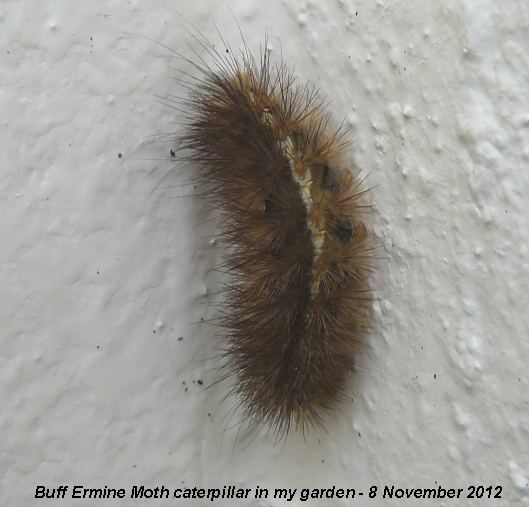
THURSDAY
NOVEMBER 8 - 2012
MY
GARDEN
Grey
Squirrels
For the second day
running I had a surprise when I got down this morning
and looked out of the back window. Two Grey Squirrels
were frolicking around on the grass in the back
garden. They took it in turns to explore the bird
table which was almost bare of any food and the
hanging feeders. We have had a regular Grey Squirrel
for a few weeks, but never before have two been seen
in the garden.
The BTO have reported
an increase in Grey Squirrels in gardens with the
reporting rate for this autumn being well up on those
of the previous 3 years. This sharp increase in garden
presence presumably indicates a lack of natural food,
ie nuts, in the environment. See . . .
http://www.bto.org/volunteer-surveys/gbw/gardens-wildlife/garden-mammals/a-z-mammals/grey-squirrel
Bumblebee
I could only see one
late insecxt feeding on the Ivy flowers in the garden,
though most of the flowers do appear to have finished.
This looks like Bombus pascuorum which
is the latest Bumblebee to be found feeding in late
autumn.
CORRECTION
- Martin
Jenner e-mailed to say the insect feeding on Ivy
flowers is in fact a hoverflly. He said they look like
Eristalis tenax (a bee mimic), though it is difficult
to tell from the angle. Martin says, if you look
closely you will see it has only one pair of wings,
whereas Hymenoptera which include bees have two pairs.
Here is one for example.

Caterpillar
We have had a very
hairy caterpillar on the outside wall of our house for
the past few days. It crawls around very slowly, maybe
looking for somewhere to hibernate? My tentative
identification is Garden Tiger Moth ie 'Woolly Bear.
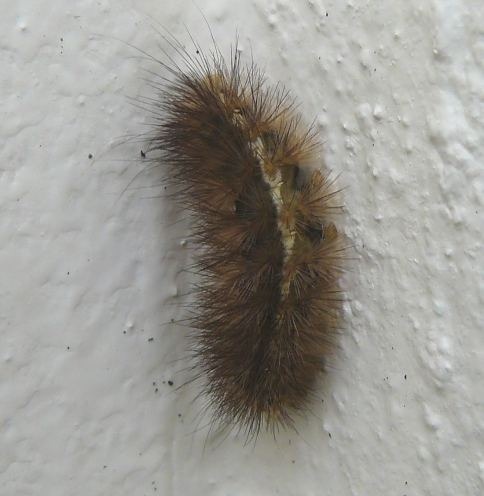
SLIPPER
MILLPOND
Reedbeds
On my way to the
marina, I met Nick Medina who was inspecting the
growth of Common Reeds in the north-east corner of
Slipper Millpond. He said they needed to be contained
from spreading into the main pond and had the idea of
digging out a deep channel to restrict their growth.
But he emphasised there was no intention of removing
or damaging what is a very fine wildlife habitat.
Old
wall
Nick also pointed out
a fine old garden wall, backing onto the reedbed,
which had recently been cleared of bramble. He said
there were discussions about whether to plant bushes
in front of the wall, but I argued strongly that the
wall itself was such a fine wildlife habitat that it
should be left as it is and not covered. Currently, it
has a good growth of Pellitory-of-the-wall and some
Hartstongue Fern, with the possibility of more fern
growth in the future. Also, the warmth of the wall
facing south would be a great attraction to insects,
as would the cracks in the brickwork.
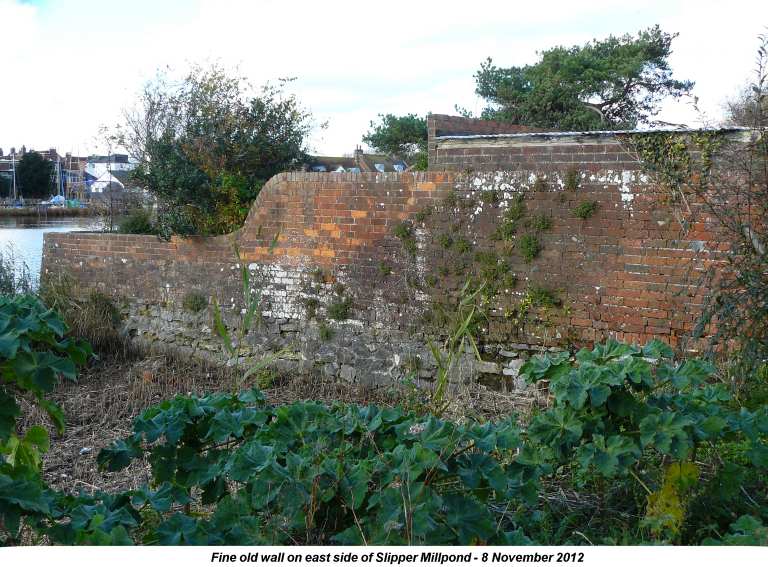
Common
Darter
As if to prove my
point, as we were talking, a male Common Darter flew
in and perched on the wall, basking in the warm
sunshine. This was the first Common Darter I had seen
since Oct 16, though I have had a couple reported more
recently. Brooks and Lewington say that their flight
season in mild autumns has been known to last through
until November or, in rare instances, December.

EMSWORTH
HARBOUR
12:00 - Viewing from
the marina seawall. The tide was well out, though
rising to high water at 17:47.
Black-tailed
Godwits
I counted a total of
142 Black-tailed Godwits on the mudflats, which was
the largest count in Emsworth this autumn. Most of
them were snoozing on one leg, so I was only able to
check a few of them for colour-rings. I found two
colour-ringed birds, both regulars in Emsworth this
autumn.
G+WR - This was the
9th sighting this season.
WO+LW flag - This was
the 5th sighting this season.
Brent
Geese
I counted 186 Brent
Geese in the main channel with no juveniles. That
brings my current juvenile to adult proportion down to
2.19% which clearly suggests a very poor breeding
season for the Brents.
OTHER
NEWS
Martin Gillingham
reported on HOS News seeing an astonishing 126
Red-breasted Mergansers in Langstone Harbour on
Nov 7 along with what are probably the first 5
Goldeneye of the winter.
ASH
DISEASE
The Forestry
Commission have a very useful web page giving details
of this potentially catastrophic disease caused by a
fungus Chalara fraxinea which could kill
most of our Ash trees. The fungus blocks the channels
that carries water up the trunk of trees and starves
them of water. Ash is our 3rd most numerous tree after
Oak and Birch.
This link illustrates
the main symptoms and also has a very good video
demonstrating the main features of the disease. There
is also a map showing the present extent of the
disease. Most cases are in East Anglia, but there is
also a cluster in Kent and scattered sites around the
country. There is also information about reporting the
disease. However, the prospects of stopping the
disease seem remote as it is carried by airborne
fungus spores. The best chance seems to be by
discovering how 10% of trees in Denmark have resisted
the disease.
See .. . .
http://www.forestry.gov.uk/chalara
WEDNESDAY
NOVEMBER 7 - 2012
GARDEN
BIRDS
Birds
return
After several weeks
with very few birds in the garden, the cold weather
has finally prompted a return. Over the past two weeks
I have recorded 15 species. Most are regular daily
visitors - Goldfinches (up to 10), Woodpigeons (up to
6), Chaffinch (up to 3), Greenfinch (up to 4),
Collared Dove (up to 4). Others are occasional, not
daily, like Blackbird, Blue Tit, Dunnock, Great Tit,
House Sparrow, Robin. I have also had brief visits
from Coal Tit, Long-tailed Tit (about 20 came through
one day), Great Spotted Woodpecker (female) and
Starling (now a great rarity). The Grey Squirrel is
now a regular visitor to the garden for the first time
in 15 years. It comes and goes frequently during the
day.
Goldcrests
When I came down for
the first time this morning, three Goldcrests were
flitting around the shrubs outside the back window.
They were constantly on the move and did not stay
long, but I grabbed my camera nd managed to get a few
snaps through the window. This was the best I could
get.
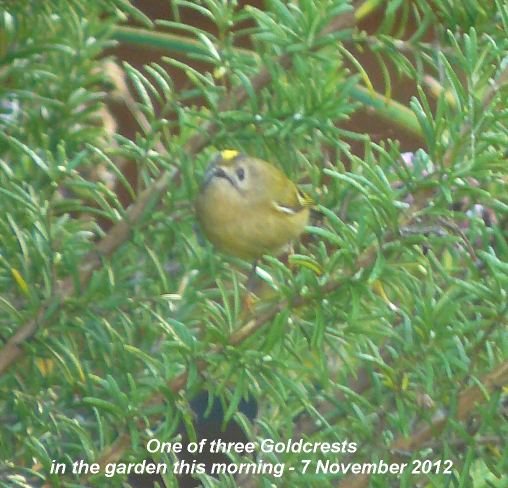
Goldcrests are very
rare in my garden, usually not more than one or two
sightings each year. The last one was in December 2011
and before that February 2009. Interesting to hear
that Tony Wootton also had Goldcrests on Brook Meadow
today. Not the same ones surely?
Goldcrest is ranked
25th in the BTO garden bird list for this quarter of
the year in the south-eastern area, having been
reported in about 7% of gardens. http://blx1.bto.org/gbw-dailyresults/results/gbwrt2012-53-7.html
TONY'S
NEWS
Brook
Meadow
Tony Wootton had a
lovely walk around Brook Meadow this morning and saw
Great Spotted Woodpecker and heard Green Woodpecker.
Blue, Great and Long-tailed Tits were also about. Tony
also saw two Goldcrests on the causeway and a
Treecreeper in the willows next to the sluice gate.
The Blackbird in the photo was bathing on the bend
north of north bridge. , the GCs where on the path
from the seat to the Lumley gate, and the TC was in
the willows next to sluice gate.
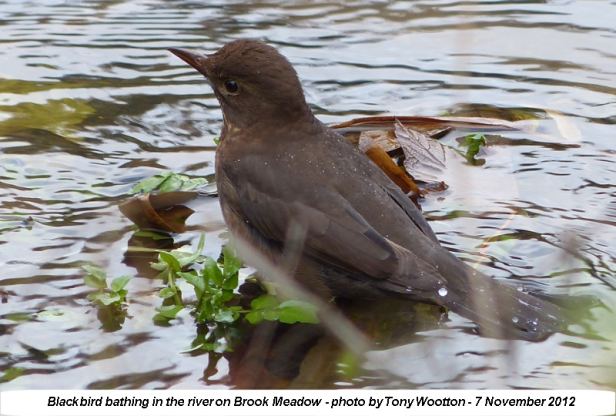
Emsworth
Harbour
Later, Tony had a look
at the harbour. In the stream to the east of the
Emsworth Sailing Club, Tony found a Greenshank and a
Little Egret feeding. He got some photos of the Little
Egret, one clearly showing a shrimp in its beak.
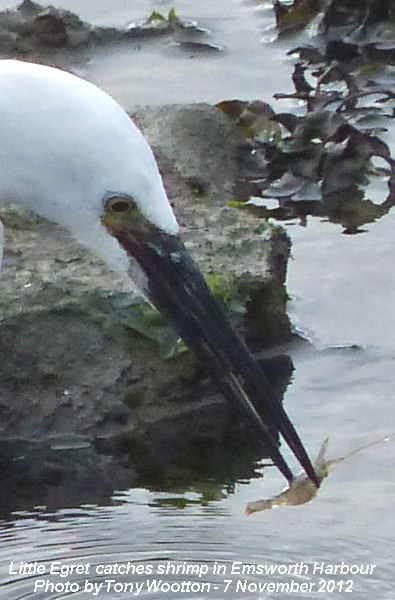
One of Tony's photos
also showed the Little Egret seemingly 'spurting'
(like we have often seen in Black-tailed Godwits and
others), though he thinks it was just the water
running back out of the bird's open beak.
Tony also went over to
Nore Barn for the Spotted Redshank, but did not see
it. He blamed the noise from the dumpers trucks going
back and forth in rebuilding the seawall, but in my
experience it would take much more than a few trucks
to disturb our Spotshank.
TUESDAY
NOVEMBER 6 - 2012
NORE
BARN
12:45 - 13:45 - Tide
rising to high water in about 2-3 hours at 15:30.
Conditions were very good with hazy sunshine and just
a light wind. The tide was rising fast and gradually
filling the stream.
Two
Spotted Redshanks
Two people were on the
beach when I arrived, Graham Petrie from Bedhampton
who I had not met before, and Ron from Emsworth who I
met here last week. They were both admiring the
Spotted Redshank and the Greenshank, which were
showing very nicely in the stream area. They were
pleased when I pointed out a second Spotted Redshank a
little further out in the harbour; this was the one
with the darker legs. The second Spotted Redshank did
not join the other two shanks in the stream.
Other
birds
The first Lapwing
of the autumn was on the bank of the stream, this
is probably the regular bird that feeds in this area
each winter. What a cracking bird this is.
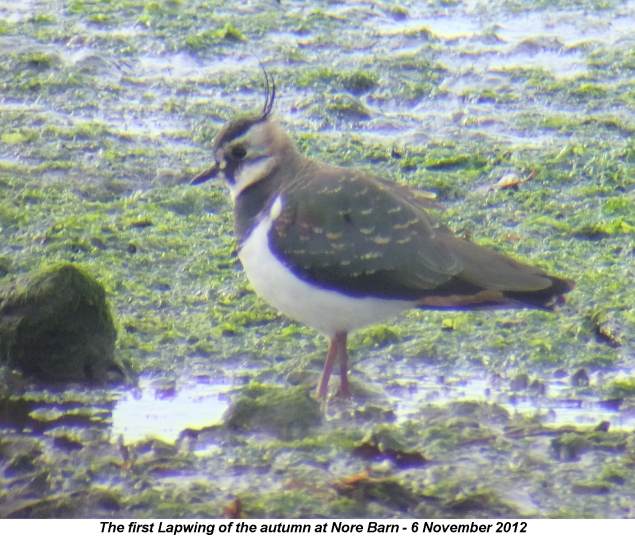
The Black-tailed
Godwits were rather flighty today and I did not
have the time to catch up with them. There were the
usual Brent Geese and Wigeon on the water, along with
just two Teal. I think the ducks should build up in
numbers as winter kicks in.
Another first for this
winter season were four Pintail (two males and
two females) that I spotted with my scope in the main
Emsworth Channel in the eastern harbour. Again, I
expect numbers of these to build up as winter
progresses.
Insects
There were plenty of
insects feeding on the mass of flowers of the large
Ivy hedge at the end of the coastal path to Nore Barn.
What a fine nectar source this hedge is. In addition
to the Drone-flies (Eristalis pertinax) that I saw
here on Nov 3, there were also several flies (e.g.
Bluebottles), Common wasps and some Bumblebees, which
looked like Bombus pascuorum which I have previously
seen this autumn. The one in this photo is covered in
pollen from the flowers.
CORRECTION
- Martin
Jenner e-mailed to say the insects feeding on Ivy
flowers which I labelled as bumblebees are in fact
hoverflies. He said they look like Eristalis tenax (a
bee mimic), though it is difficult to tell from the
angle. Martin says, if you look closely you will see
it has only one pair of wings, whereas Hymenoptera
which include bees have two pairs.
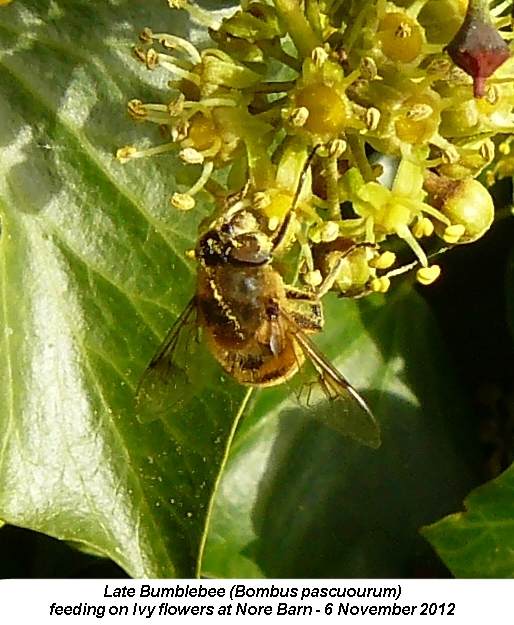
OTHER
NEWS
Water
Vole
Maurice Lillie was
surprised and delighted to see a Water Vole this
morning at 08:40 located 25 metres north of north
bridge on west bank. This was our 202nd sighting on
Brook Meadow this year. Maurice said the animal sped
southwards along the almost bare river bank for about
2metres, hid behind ivy then emerged into shadowy
sunlight. It sat motionless for about two minutes then
ran behind an ivy growth appearing seconds later in
the water, swam behind overhanging ivy in and out of
view.
Maurice did not manage
to get a good photo of the Water Vole, but he did turn
his camera to capture the view from the north bridge
looking south. What a beautiful autumn morning on
Brook Meadow.

Cormorants
raft
The local Cormorants
have a nice new raft to perch on, and hang their wings
out to dry, on the town millpond, inadvertently
provided, I suspect, by one of the Emsworth sailing
clubs.
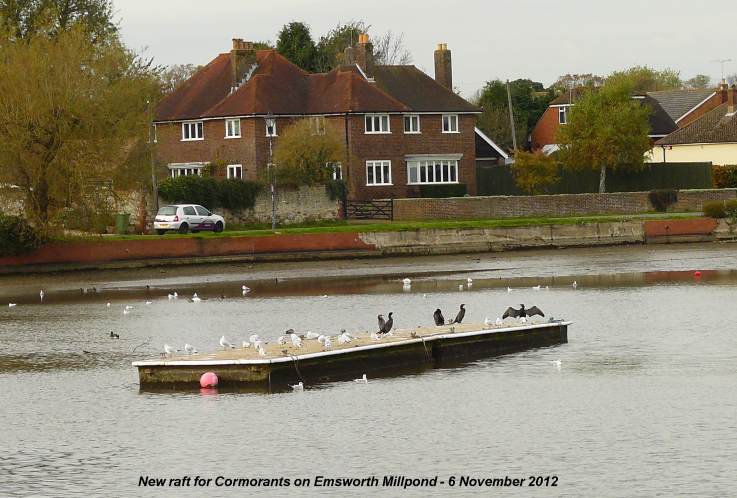
Honey
Fungus on verge
Keith Wileman sent me
a couple of photos of fungi growing on the grass verge
opposite no.1 Danbury Court. They look very much like
those he found in December last year (06.12.11) which
were identified as Honey Fungus. They are growing near
a tree which is not good news for the tree, I suspect.
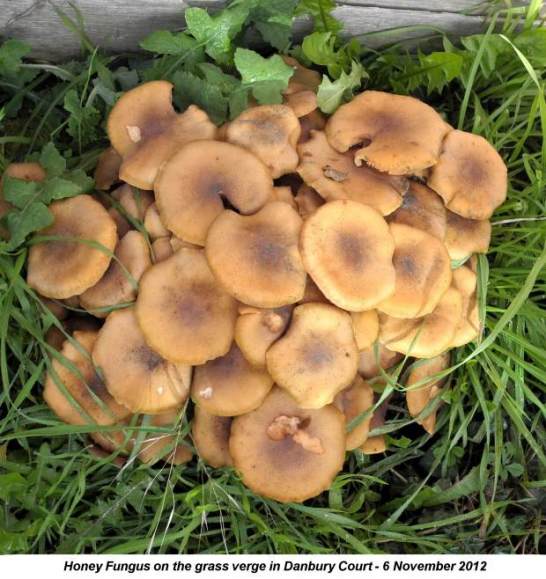
Nuthatch
in Bedhampton garden
Graham Petrie, whom I
met for the first time at Nore Barn this morning, has
had a good selection of wildlife in his Bedhampton
garden, including Nuthatch, Great Spotted Woodpecker,
Slow-worm, lizards, newts in the pond, along with
dragonflies, damselflies and lots of butterflies.
Graham sent me this photo of a Nuthatch on a bird
feeder. Now, that is what I call a really good feeding
station for birds!

Grey
Squirrel feast
Tony Wootton got this
image of a Grey squirrel having a sloe feast at
Pulborough today. So that's what they really like!
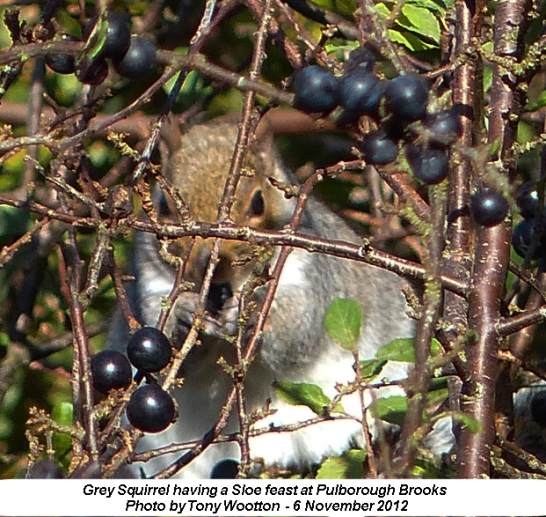
Pheasant
on Brook Meadow
Debbie Robinson saw a
hen pheasant in Brook Meadow a couple of weeks ago
(Mon 22 or Tues 23 October). She (the Pheasant that
is) was walking nonchalantly through the nettles near
the sacrificial area only a few feet away. Debbie
thinks she'd been hiding out behind the sacrificial
area for a few days, because her dog, Rosie, galloped
into that boggy tree-y area over the weekend - very
much on a hunting mission. Pheasants are not often
seen on Brook Meadow, but there are a few sightings
each year. Debbie's was the second this year.
The
Havant Water Vole
Ralph Hollins provided
the following information about the Water Vole seen on
Oct 27 munching Water Cress in broad daylight in the
central Havant pond beside the main road into Havant
from the A27 (opposite the turning into Solent Road
where the Havant TESCO is sited)
Ralph says, "This was
very surprising but the description did not fit that
of a Brown Rat, the only species likely to be confused
with Water Vole, so I searched the Internet for
evidence that Water Voles do wander away from the
places where they are normally seen and found it in a
BBC article at http://www.bbc.co.uk/news/science-environment-19503827
This confirms that
they do occasionally travel long distances. A study of
small isolated groups of these Voles in Scotland
showed that younger animals which, for whatever
reason, feel the need to leave their family and its
limited territorial area of few hundred square metres,
would wander several kilometres before settling down
in a new territory - the longest recorded journey in
this limited study was one of 15 kilometres. This
study shows that occasional sightings of Water Voles
in places where there is no known established colony
of them are probably of individual animals engaged in
these youthful wanderings and , although not stated in
the summary published on the BBC website, the autumn
seems the most likely time for such journeys to take
place (when young born earlier that year have grown
sufficiently to travel and are most likely to feel the
urge to do so before they are stuck at home for the
winter).
The pond where this
sighting was made is a likely place for a Vole to
pause in its travels after coming up the Langbrook
Stream and, after passing under the A27, taking a
right turn off the narrowing main stream north of the
'Water Wheel' into the less polluted water of the
minor stream which flows out from the Homewell Spring
near St Faith's Church. After coming to a dead end
there the Vole might well have turned back and decided
to stock up on food while wondering where to go
next."
MONDAY
NOVEMBER 5 - 2012
STANSTED
FOREST
I had a pleasant
couple of hours this morning wandering through the
northern areas of Stansted Forest near Forestside. The
sun was warm, but there was a chilling north wind. The
paths were extremely muddy. The autumn colours of the
forest were most beautiful.
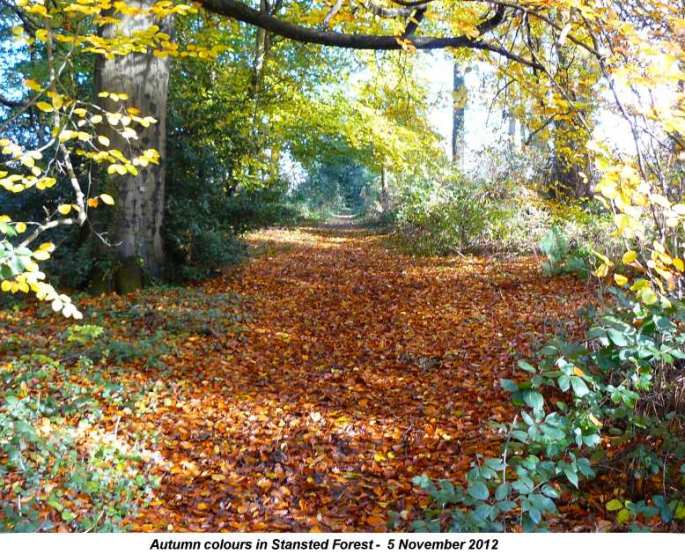
Norway
Spruce cones
I found a good
quantity of long cigar-shaped brown cones on the
ground along the path going west from the Forestside
Road towards Rowlands Castle. They are from Norway
Spruce which is the familiar Christmas tree, though
not so familiar these days with many new varieties
being sold.

Black
Bryony
I found several
growths of Black Bryony hanging from the hedgerows
with red, green, orange and yellow berries. The
berries are poisonous. I have often wondered why this
plant was called Black Bryony. In fact, it gets its
name not from its fruits but from the colour of its
fleshy underground roots.
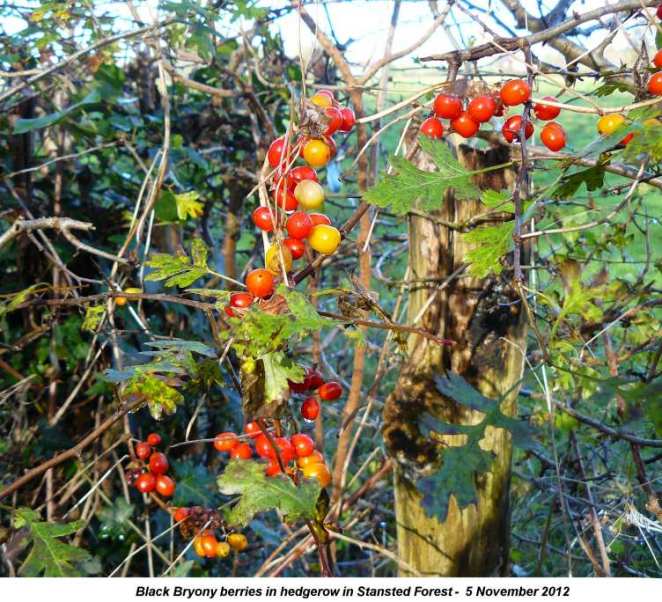
Wasps
on Ivy flowers
I looked carefully at
the Ivy flowers along the paths, but found only what I
think were Common Wasps feeding on them. There was no
sign of any bees or hover flies.
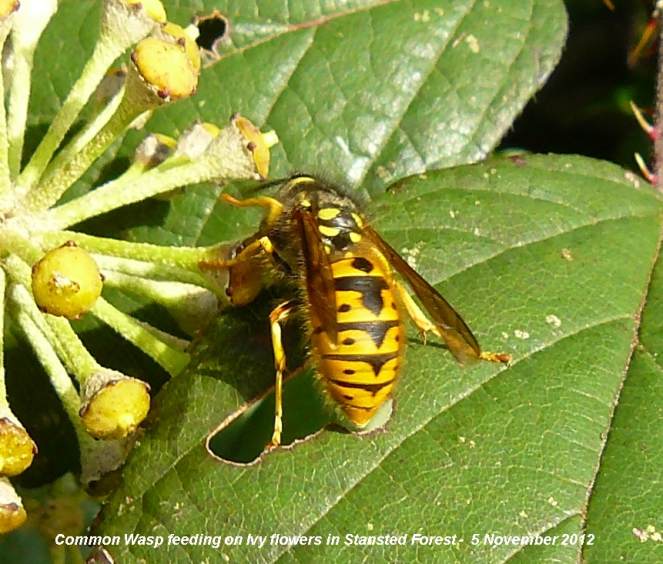
Wild
flowers
I found several plants
of Wavy Bitter-cress in flower (with 6 stamens)
along the very wet path going east from the Forestside
road. But more prominent was an abundant growth of
Water-pepper with what seemed to be fresh
flower buds, though I could not see any open.
Sweet
Chestnuts
I could not see many
Sweet Chestnuts on the ground and what there were
small and not ripe. This contrasts with the Hollybank
Woods where, according to Andy Brook, there has been
an excellent crop.
Medlar
fruits
The Medlar tree just
inside the gate to the Stansted arboretum from the
walled garden has lots of fruit. The medlars come away
from the tree very easily, though I gather they cannot
be eaten raw until 'bletted' ie allowed to become over
ripe to the point at which the flesh softens and
starts to rot, but before the outer skin shows signs
of decay. If the fruit is left on the tree the frost
will start the bletting process.
NORE
BARN
12:15 - 13:00 - About
2-3 hours before high water.
Two
Spotted Redshanks
Two Spotted Redshanks
were already feeding in the stream when I arrived
along with a Greenshank, one with darker legs than the
other. Two other birdwatchers, Ann and Sylvia, were
also present and were particularly excited to see the
two Spotted Redshanks in the stream. I tend to get a
bit blasé, but it really is quite exceptional
to get such a good close view of two Spotted
Redshanks.
The
chase
Ann, Sylvia and I then
watched the 'resident' Spotted Redshank chase the
visiting, darker legged, Spotted Redshank along the
stream.
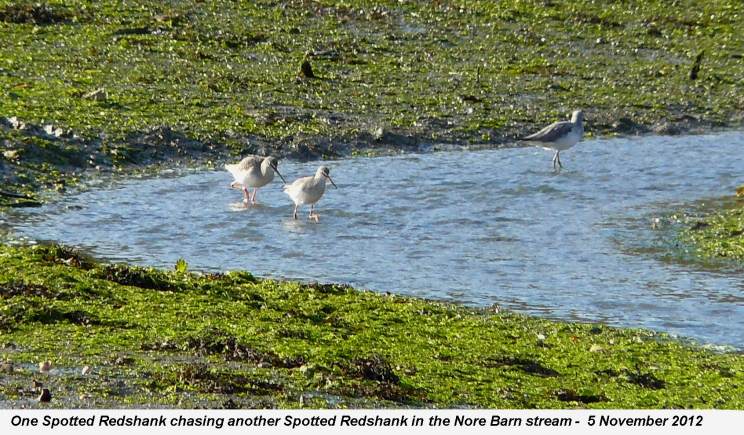
They had a mini
confrontation, beak to beak, before the visitor flew
off to the saltmarshes not to be seen again.
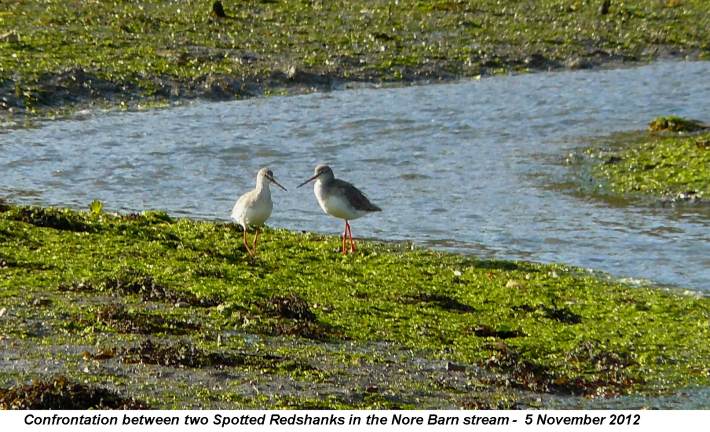
The chase was not what
I would call aggressive, but the resident bird seemed
determined to defend its feeding territory. The
resident Spotted Redshank then returned to feeding in
the stream with its 'friend' the Greenshank which had
carried on feeding while all this was happening.
Spotted
Redshank feeding
The stream was filling
up with the tide and I was interested to observe and
take photos of the Spotted Redshank feeding. The
feeding behaviour was active and fairly vigorous with
the bird frequently digging its head deep into the bed
of the stream searching for food.
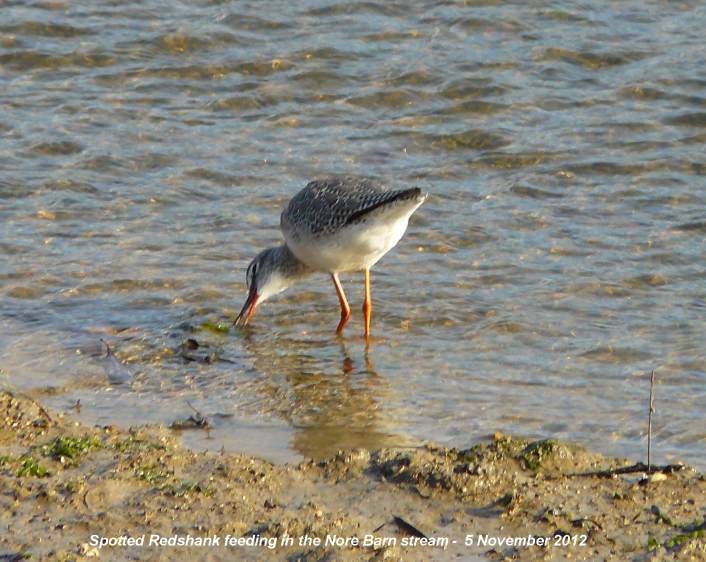

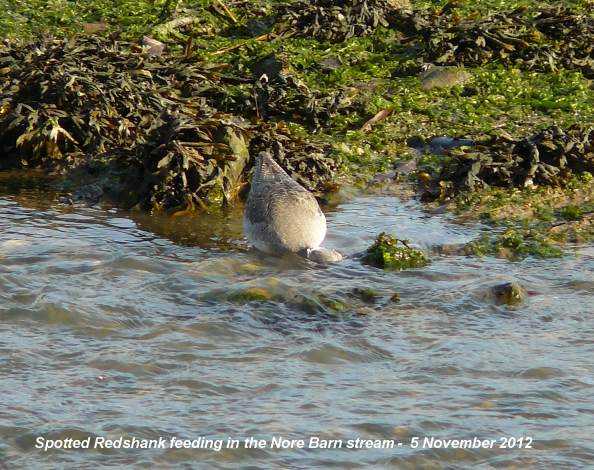
For
more Spotted Redshank news and photos go to .
. .
Spotted
Redshank
With one, two and
possibly three Spotted Redshanks in Emsworth, we still
have some way to go to catch up with the 14 that were
present on the Lymington shore on Oct 28.
OTHER
NEWS
Tony Wootton was at
Nore Barn this afternoon and got this excellent image
of a Long-tailed Tit.
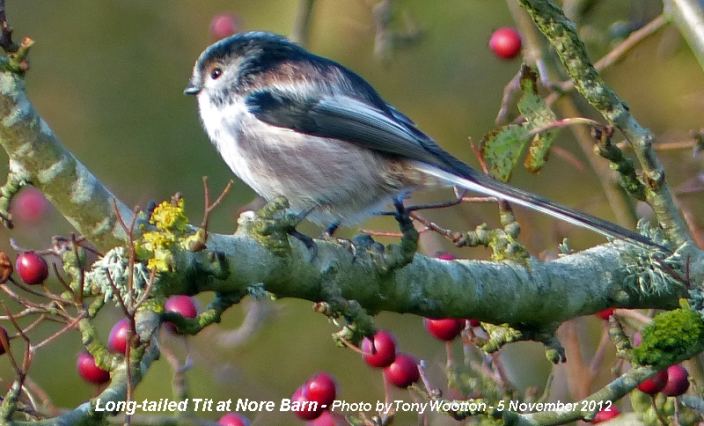
On Sat 3rd Nov Dave Oliver saw a Short-eared
Owl at Chidham, Bosham side. It is some years
since hen last saw one and presumes they are moving
through.
SUNDAY
NOVEMBER 4 - 2012
Drone
Fly
Many thanks to Ralph
Hollins and Tony Davis for pointing out that the
hoverfly I photographed on Nov 3 on Ivy flowers at
Nore Barn is in the genus Eristalis, and not, as I
tentatively suggested, Syrphus ribesii.

Tony thinks it could
be Eristalis pertinax but could not be
sure from the photo. The genus Eristalis is also known
as Drone-fly from its remarkable resemblance to a
Honey bee drone. Eristalis pertinax is called Tapered
Drone Fly from the more tapering abdomen in the male,
but the species are very similar. Flight period: March
to November, with peaks in May and August. It visits a
wide range of flowers, very often in company with the
honey bees it mimics.
See . . .
http://www.naturespot.org.uk/species/tapered-drone-fly
SATURDAY
NOVEMBER 3 - 2012
EMSWORTH
HARBOUR
10:00 - 11:30 - I
walked from the Emsworth Sailing Club along Western
Parade to Nore Barn basically following the rising
tide. High water was due at 13:30.
Brent
Geese
Brent Geese were
scattered around the western mudflats. I counted a
total of 172, but could only find one juvenile. This
is a regular in Emsworth, but there was no sign of the
other families with two juveniles that I have seen
here. My current proportion of juveniles is 3.00%.
About 200 Dunlin were lining the edges of the main
channel.
Black-tailed
Godwits
10:30 - A small flock
of 12 Black-tailed Godwits were in the lower stream
where it merges into the main harbour. Over the next
30 minutes small groups of Godwits flew in from the
east to swell the numbers at Nore Barn to 56. There
were no colour-rings that I could see.
Spotted
Redshanks
Spotted Redshank and
Greenshank were already in the stream when I arrived
at Nore Barn at 10:30 and remained there until I left
about an hour later at 11:30. They were feeding close
together for a while. Then the Spotted Redshank moved
up the stream to feed near to upper bend, close to
where I was standing to the west. I had not seen it
feeding this far up the stream this autumn.

The Spotted Redshank
was constantly digging deep in the stream and in one
of my photos I discovered that it appeared to be
spurting out water from its bill at the end of a
feeding episode.

I have previously seen
this behaviour mostly in Black-tailed Godwits, but it
appears to be also not uncommon in Spotted Redshank
and in Common Redshank. The experts are currently
puzzling over this behaviour which, very surprisingly,
has not been previously recorded. See the special page
on spurting . . Spurting
behaviour
While I was going
through the godwits for colour-rings, I came across
a second Spotted Redshank. It was not ringed
and had darker legs than the bird in the stream, so
this was probably the second Spotshank that I saw
earlier in the week. I was hoping it might join the
other Spotshank in the stream, but it remained with
the godwits and flew off with them when the tide
pushed in.
Insects
on Ivy
There is a magnificent
hedge of Ivy at the far western end of the path to
Nore Barn, just before the end of Warblington Road.
The flowers were attracting a number of
insects.
Many thanks to Ralph
Hollins and Tony Davis for pointing out that the
hoverfly is in the genus Eristalis. Tony thinks it
could be Eristalis pertinax but could
not be sure from the photo. The genus Eristalis is
also known as Drone-fly from its remarkable
resemblance to a Honey bee drone. Eristalis pertinax
is called Tapered Drone Fly from the more tapering
abdomen in the male, but the species are very similar.
Flight period: March to November, with peaks in May
and August. It visits a wide range of flowers, very
often in company with the honey bees it mimics.
See . . .
http://www.naturespot.org.uk/species/tapered-drone-fly

OTHER
NEWS
Malcolm Phillips sat
down at Langstone and watched the tide come in. There
was lots of bird activity, including Lapwings
in flight.
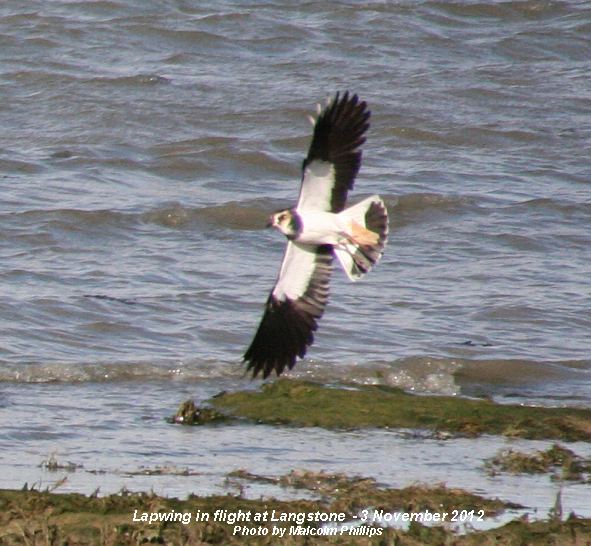
Colin Vanner was at Farlington Marshes and captured
this Red-breasted Goose on the marshes with a
flock of Canada Geese. This bird was first seen on
Farlington by Bob Chapman on 25 October.
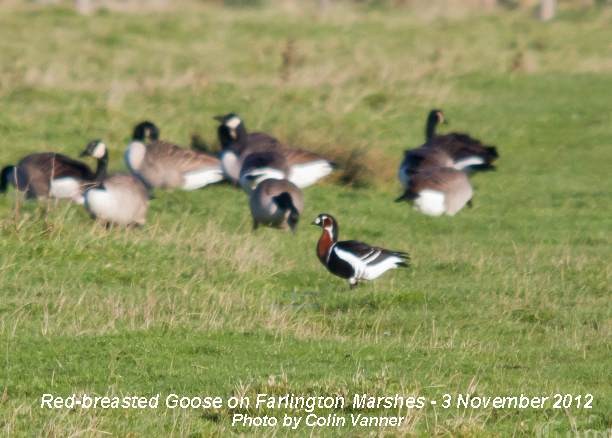
Caroline French reported on this morning's walk by the
Havant Wildlife Group inwhich they saw a Swallow
and 20 Avocets. See the full report at . . .
Saturday
walks - reports 2012
FRIDAY
NOVEMBER 2 - 2012
EMSWORTH
HARBOUR
10:00 - Tide rising to
high water at about 13:00. The weather was nasty, with
a cold westerly wind blowing constant showers of rain
across the harbour. I sheltered for a while at the
Emsworth Sailing Club where I was entertained by a
mixed group of birds feeding amongst the seaweed to
the west of the building, including Black-tailed
Godwit, Redshank, Turnstone and Starlings.
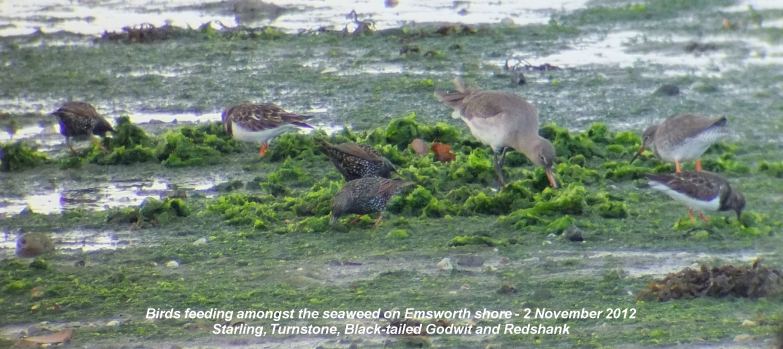
There were plenty of
Brent Geese and a small flock Black-tailed Godwits on
the rapidly receding mudflats, but I did not have the
chance to go through them for colour-rings. I
struggled along to Nore Barn where the stream looked
completely empty. That was when I gave up. Enough is
enough!
BROOK
MEADOW
Agrocybe
cylindracea
What looks very much
like Agrocybe cylindracea is growing on a tree stump
beneath the eastern approach to the south bridge.
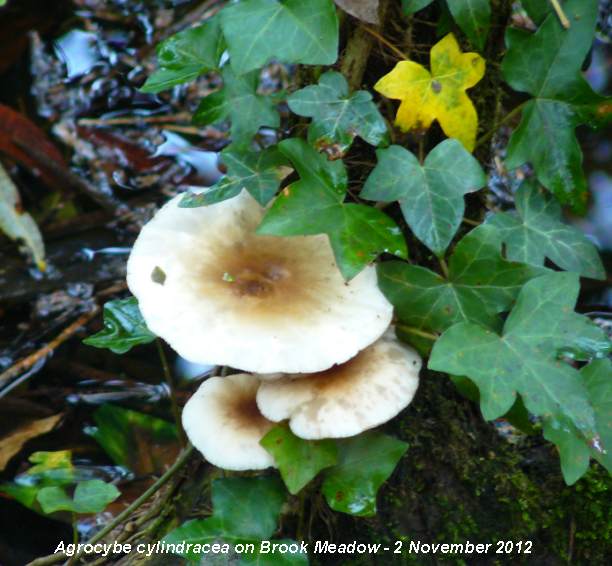
I have seen it growing
in this area in previous years. However, this fungus
is nowhere near as prolific as it was in the years
2002-2005 when I regularly discovered numerous caps
growing on the Crack Willow stumps. I recall picking
some for frying and they were very good!
Flowering
Plants
I made a start on my
flowering plants list for November today in the local
area. I had a look around the new Emsworth Railway
Station wayside, Bridge Road Wayside and Brook Meadow
and found 41 in flower, including grasses showing
fresh spikelets.
PETER'S
NEWS
Peter Milinets-Raby
had a few late flying insects in his Havant back
garden during the bright sunny spells between the
showers. They included a Red Admiral butterfly and a
female Common Darter dragonfly. They were very
lethargic in the cold and obviously warming themselves
up in the sun. This enabled Peter to get some
incredibly close photos, like the following one of the
head of the Common Darter.

Both these species are
not unusual at this time of the year, in fact, Red
Admirals are now acknowledged as 'an-all-year-round'
butterflies.
There was no sign of
the Black Redstart which Peter had in the garden
yesterday (see the photo for Nov 1), though he did
have 15 Blackbirds in the garden, which was very
unusual (2 to 3 is the norm). They were probably
wintering migrants from the Continent.
THURSDAY
NOVEMBER 1 - 2012
NORE
BARN
09:30 - 10:30 - About
3 hours to high water at 12:30. Heavy showers with
strong westerly wind made birdwatching a bit
uncomfortable. However, the scene was idyllic with a
good flock of Black-tailed Godwits and the calls of
Brent Geese wafting over the mudflats.
The stream was still
running fast when I arrived with the Greenshank
feeding. The Spotted Redshank did not arrive
until about 10:00. It remained on the shore at the
point, snoozing and preening. It finally walked round
the shore to the stream and by 10:15 it was feeding
with the Greenshank.
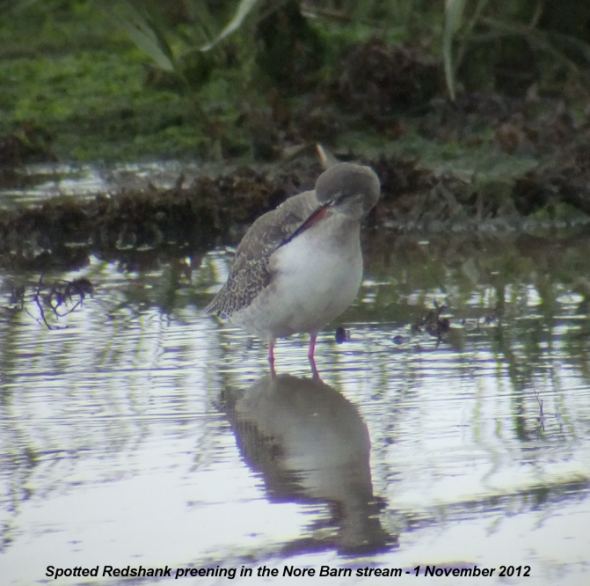
By 09:45 most of the
Black-tailed Godwits had moved into the Nore
Barn Creek, where I counted 82. I checked them for
colour-rings, but only found one - WO+LW flag -
My 4th sighting this autumn. Ringed as a chick in
north Iceland by Ruth Croger and Pete Potts on 13th
July 2009 at Langhus, SW of Siglufjordur. It has been
regular in Emsworth over the past two winters.
The flock of Mute
Swans at Nore Barn was up to 19 this morning including
the 4 cygnets.
BLACK
REDSTART
Peter Milinets-Raby
had a Black Redstart in his Havant garden this morning
at 10:20am for 5 minutes. It hopped around the pond,
then flew out on the waste ground at the back of the
house where it loitered until 11:30am at least. Peter
only had his mobile phone available so the photo is
not up to his usual standard, but the bird is clearly
identifiable. It looks like a female or 1st year bird.
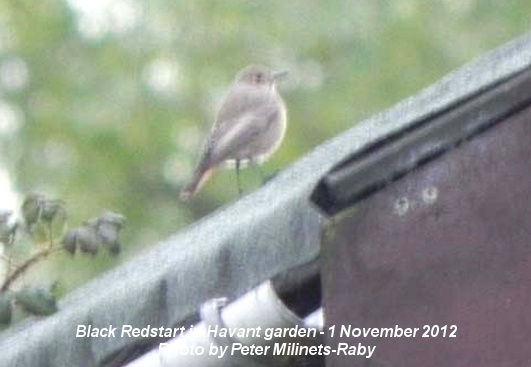
Black Redstarts breed
mainly on the Continent and are seen in the South of
England as scarce passage migrants. Peter's bird is
probably one that stopped off in his garden for a feed
and a rest on its way to winter in Southern Europe.
November is their peak passage month. A few Black
Redstarts do remain for the winter in our area, so
this one may hang around.
Black Redstart is
rarely seen in gardens despite being extremely common
in towns in many parts of Europe. My last record of
one locally was of a male, still in breeding plumage,
photographed by Mary Colbourne in her Emsworth garden
on 17 November 2010.
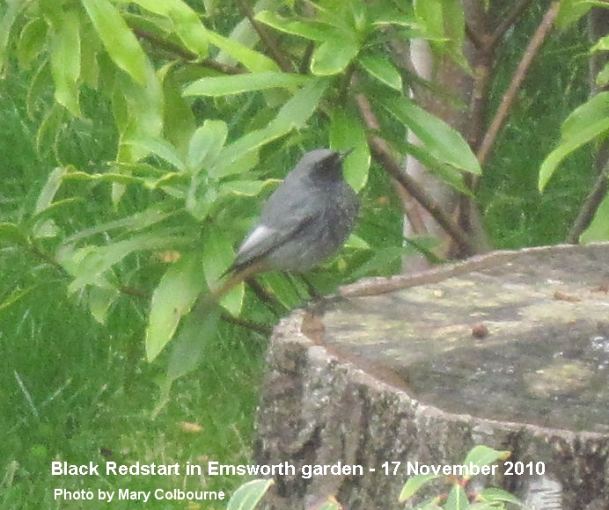
For
earlier observations go to . . . .
October
16-31